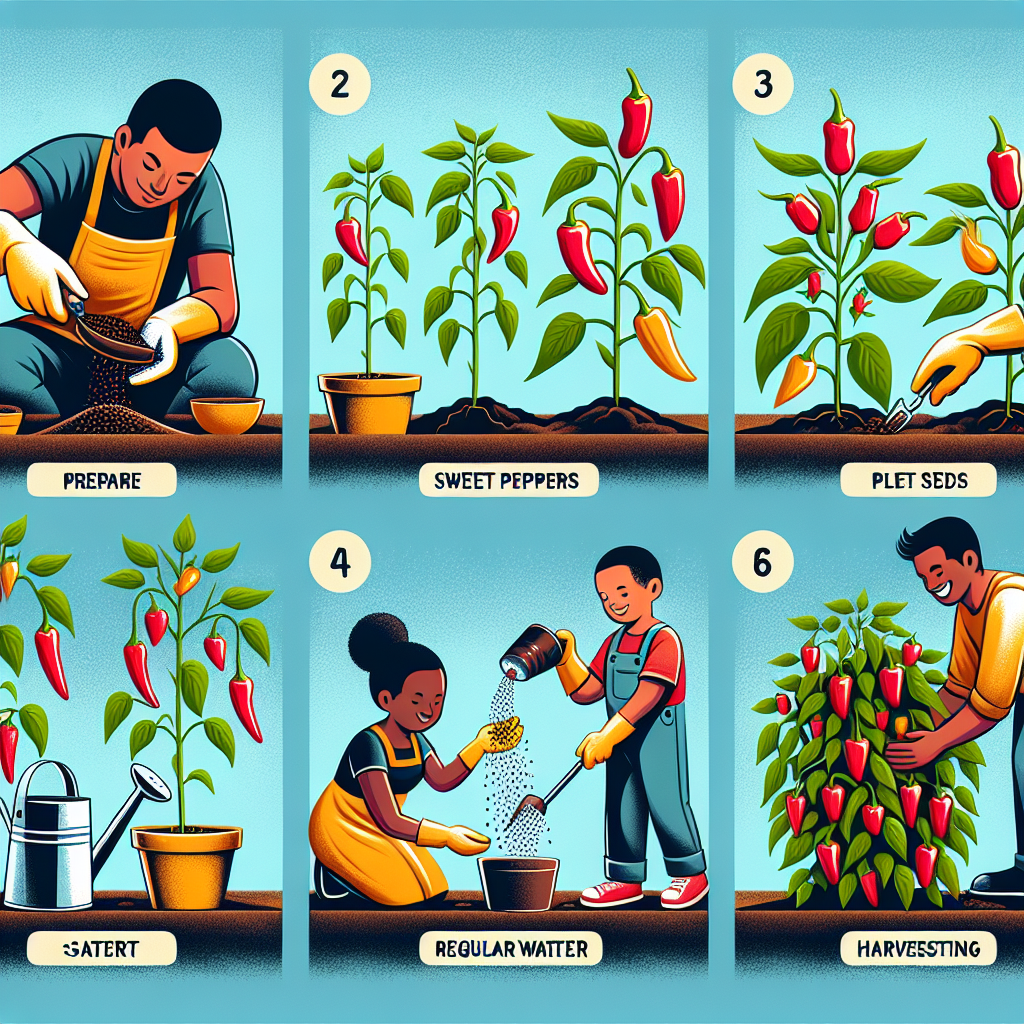
How to grow sweet peppers
Introduction to Growing Sweet Peppers
Sweet peppers, known for their vibrant colors and delicious flavor, are a popular choice among home gardeners. Not only do they enhance the taste of various dishes, but they are also packed with vitamins and nutrients. If you're looking to cultivate these delightful vegetables in your garden, understanding how to grow sweet peppers effectively is key. In this guide, we’ll walk you through the various steps and tips to ensure a successful harvest of sweet peppers.
Choosing the Right Varieties of Sweet Peppers
Before delving into the cultivation process, it's important to pick the right variety of sweet peppers for your garden. Here are some popular types:
- Bell Peppers: The most common type, available in green, yellow, red, and orange.
- Cherry Peppers: Small, round peppers that are mildly sweet.
- Pimiento Peppers: Heart-shaped and known for their sweetness.
- Anaheim Peppers: Slightly spicy but can be sweeter when harvested early.
Factors to Consider When Choosing Varieties
When selecting sweet pepper varieties, consider the following factors:
- Climate: Some varieties thrive better in warm climates than others.
- Growth Habit: Determine whether you prefer bushy plants or tall varieties.
- Space Availability: Assess the area you have for planting and choose accordingly.
Preparing the Soil for Planting
Sweet peppers thrive in well-drained, nutrient-rich soil. Here’s how you can prepare your soil:
Soil Composition
The ideal soil for sweet peppers is a loamy, sandy mix that provides adequate drainage. Here are elements to consider:
- pH Levels: Aim for a pH of 6.0 to 6.8.
- Organic Matter: Add compost or well-rotted manure to enrich the soil.
- Drainage: Ensure the area does not stay soggy; raised beds can help improve drainage.
Preparing the Garden Bed
Follow these steps to prepare your garden bed:
- Clear the Area: Remove weeds, rocks, and debris from the area you want to plant.
- Till the Soil: Use a garden fork or tiller to loosen the soil to a depth of about 12 inches.
- Add Amendments: Mix in compost and any necessary fertilizers based on your soil test results.
- Level the Bed: Ensure the garden bed is flat to promote even watering.
Starting Sweet Peppers from Seeds
Growing sweet peppers from seeds is a rewarding endeavor. Here’s how to do it:
Seed Selection
Choose high-quality seeds from reputable suppliers. Look for those that are specifically labeled as sweet peppers.
Starting Seeds Indoors
If you want to get a head start on the growing season, follow these steps:
- Timing: Start seeds indoors 8-10 weeks before the last frost date.
- Use Seedling Trays: Fill trays with seed-starting mix.
- Sow Seeds: Plant seeds about ¼ inch deep and cover lightly.
- Water Gently: Moisten the soil without soaking it.
- Provide Light: Place in a sunny spot or under grow lights.
Transplanting Sweet Peppers Outdoors
Once the seedlings are ready and the risk of frost has passed, it’s time to transplant them into the garden.
Hardening Off
Before transferring seedlings directly into the garden, you need to acclimate them:
- Start Gradually: Place seedlings outside for a few hours each day, gradually increasing the time over a week.
- Monitor Conditions: Ensure they are protected from strong winds and harsh sunlight.
Planting in the Garden
When you are ready to transplant, follow these steps:
- Spacing: Space plants about 18-24 inches apart in rows that are 24-36 inches apart.
- Dig Holes: Create holes that are large enough for the root ball.
- Water Well: Water the plants immediately after transplanting.
Caring for Sweet Peppers
To ensure optimal growth and yield, proper care is crucial. Here are key care tips:
Watering
Sweet peppers require consistent moisture. Follow these guidelines:
- Frequency: Water deeply about once a week, increasing frequency during dry spells.
- Method: Use soaker hoses or drip irrigation to minimize evaporation.
- Avoid Overwatering: Ensure that excess water does not pool around the roots.
Fertilization
Fertilization is essential for healthy pepper plants. Consider the following:
- Type: Use a balanced fertilizer or one with higher phosphorus content.
- Timing: Fertilize when planting and again a few weeks after transplanting.
- Observation: Watch for signs of nutrient deficiencies, such as yellowing leaves.
Pest and Disease Management
Keeping your plants safe from pests and diseases is vital. Here’s how to manage potential threats:
- Common Pests: Watch for aphids, spider mites, and whiteflies. Use insecticidal soap if infestations occur.
- Diseases: Look out for fungal infections; ensure good air circulation and avoid wetting the foliage.
- Mulching: Apply organic mulch to suppress weeds and retain soil moisture.
Harvesting Sweet Peppers
Knowing when to harvest sweet peppers can greatly impact their flavor and quality. Here’s how to tell when they're ready:
Signs of Ripeness
“Sweet peppers are best harvested when fully colored and firm to the touch.”
Follow these signs to ensure you’re harvesting at the right time:
- Color: Look for full coloration (green, red, yellow, or orange) based on the variety.
- Size: Check that peppers have reached their mature size.
- Firmness: Feel for a firm texture without any soft spots.
Harvesting Techniques
When harvesting, use these techniques:
- Use Sharp Scissors: Cut the pepper stem to avoid damaging the plant.
- Pearl Size: If you’re unsure, it’s better to pick pepper before they get overly ripe, especially if your goal is to enjoy sweeter flavor.
Conclusion: Enjoy the Fruits of Your Labor
By following these steps on how to grow sweet peppers, you can enjoy a fruitful harvest right from your garden. Remember that gardening is a learning experience; with patience and observation, you will improve your techniques over time. Whether you use them in salads, stir-fries, or for snacking, homegrown sweet peppers add both flavor and nutrition to your meals. Happy gardening!
By Guest, Published on September 27th, 2024